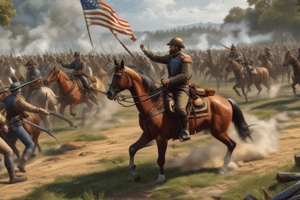Podcast
Questions and Answers
What was the primary objective of Sherman's March to the Sea?
What was the primary objective of Sherman's March to the Sea?
- To defeat the Confederate army in Georgia
- To disrupt the Confederate economy (correct)
- To capture Confederate territory and resources
- To march to the sea and establish a Union naval presence
What was the significance of the Battle of Gettysburg?
What was the significance of the Battle of Gettysburg?
- It halted General Robert E. Lee's invasion of the North (correct)
- It marked the end of the war in the Eastern theater
- It was the bloodiest battle of the Civil War
- It led to the abolition of slavery
Which of these battles had the single highest death toll?
Which of these battles had the single highest death toll?
- Battle of Antietam (correct)
- Sherman's March to the Sea
- Battle of Gettysburg
- Battle of Vicksburg
Which of these battles did not result in any lasting advantage for the Union?
Which of these battles did not result in any lasting advantage for the Union?
Which of these battles played a crucial role in shaping the course of the Civil War and the abolition of slavery?
Which of these battles played a crucial role in shaping the course of the Civil War and the abolition of slavery?
Flashcards are hidden until you start studying
Study Notes
Civil War Battles: A Detailed Look at Fredericksburg, Vicksburg, Sherman's March to the Sea, Gettysburg, and Antietam
Introduction
The American Civil War, fought between 1861 and 1865, was a pivotal period in United States history characterized by numerous significant battles. Among these battles, some stand out due to their strategic importance or their impact on the outcome of the war. These include the Battle of Fredericksburg, the Siege of Vicksburg, Sherman's March to the Sea, the Battle of Gettysburg, and the Battle of Antietam. In this article, we will explore each of these battles in detail.
Battle of Fredericksburg
The Battle of Fredericksburg took place on December 11-15, 1862, near Fredericksburg, Virginia. It resulted in a Confederate victory despite having one of the highest death tolls among individual battles. Union General Ambrose Burnside attempted to cross the Rappahannock River, but Confederate General Robert E. Lee successfully defended the city with substantial losses.
Siege of Vicksburg
The Siege of Vicksburg occurred from May 18-July 4, 1863, in Vicksburg, Mississippi. This key Union victory led to the control of the Mississippi River, which effectively split the Confederacy in half. The siege ended when Confederate General John C. Pemberton surrendered to Union General Ulysses S. Grant.
Sherman's March to the Sea
Sherman's March to the Sea was a series of Union offensives through Georgia, starting in late November 1864, with the primary objective being to disrupt the Confederate economy. The march ended on December 21, 1864, in Savannah, Georgia. The campaign was successful in its aim to weaken the Confederacy's ability to wage war.
Battle of Gettysburg
The Battle of Gettysburg took place on July 1-3, 1863, in Gettysburg, Pennsylvania. This Union victory is considered a turning point in the war, as it halted General Robert E. Lee's invasion of the North. The three-day battle had one of the highest death tolls, with over 50,000 total casualties.
Battle of Antietam
The Battle of Antietam, also known as the Battle of Sharpsburg, took place on September 17, 1862, in Maryland. This major Union success did not result in any lasting advantage, but it was the single bloodiest day in the entire war, with approximately 22,000 casualties combined for both sides.
Each of these battles played a crucial role in shaping the course of the Civil War, ultimately leading to its conclusion and the abolition of slavery.
Studying That Suits You
Use AI to generate personalized quizzes and flashcards to suit your learning preferences.




